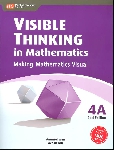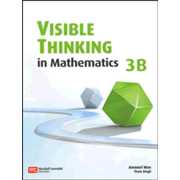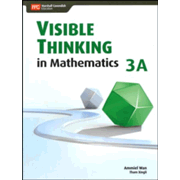The Visible Thinking in Mathematics series can serve as a supplement for most math programs for the elementary grades. There are 11 books in the series: 1A, 1B, 2A, 2B, 3A, 3B, 4A, 4B, 5A, 5B, and 6. Books might be used straddling at least two grade levels for the average student. For example, books 2A and 2B might be used for second and third graders since 2A begins with place value in the hundreds and continues through addition, subtraction, and multiplication with some work on division, and fractions. 2B continues with money, measurement (length, mass, and volume), time, graphs, shapes, and patterns.
As with Singapore Math’s Primary Mathematics series, the content increasingly moves beyond that of typical grade levels. Book 6 begins with lessons on algebraic expressions (e.g., 7d − 4 − 2d – 5) and goes on to teach topics such as geometric figures (squares, rhombuses, parallelograms, and trapeziums), three-dimensional geometric forms, equivalent fractions, ratios, percentages, comparing two ratios, speed/time/distance word problems, and the volume of liquids. This series is great for gifted learners, but it should work well with all learners as long as you select the appropriate level.
Visual models are used from time to time but always as a way to help students learn different strategies for mathematical thinking. Many exercises stress logical thinking as much as the math. For example, 4A includes the problem, “Charles had twice as much money as Dave. Ethan had twice as much money as Charles. If Ethan had $36 more than Dave, what was the total amount of money the three boys had?” It then repeats a very similar problem, changing the order of the names somewhat and one other major detail: “Charles had twice as much money as Dave. Ethan had 3 times as much money as Dave. If Ethan had $36 more than Charles, what was the total amount of money the three boys had?” (p. 42). You can see how this forces students to pay close attention rather than jumping to conclusions.
The Visible Thinking books are each self-contained with an answer key at the back and occasional teaching tips at the bottom of pages. Students have plenty of room to work directly in the books. Books are not to be photocopied, so each student needs his or her own book.
The series is not intended to provide comprehensive coverage. You would use it as a supplement, probably selecting appropriate topics as they fit with your primary course material.
The series has not been adapted for the U.S., so it uses metric measurements, and money problems with images that show Singapore bills and coins. Many money problems without images can be used without adaptation. Money is taught in books 1B, 2B, and 3B, so these are likely to be the most problematic.
Despite this minor issue, I think the series should prove very useful for those who want to help their children develop strong mathematical thinking skills. The books are easy to use, although the upper level books might challenge parents’ thinking skills as well as students’.
















